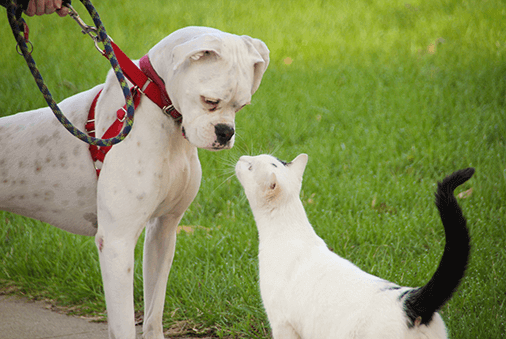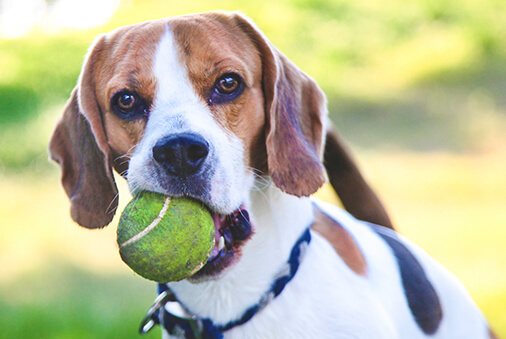Will Work for Food
Food puzzle toys help exercise your dog’s mind as he seeks to solve the puzzle to reap his delicious reward. The good news is you don’t have to spend a lot of money on sophisticated puzzle feeders.
Two treats in one activity: Place your dog’s favorite dry food in an old muffin tin and cover each section with a tennis ball. Your pal will have to move the ball to get his reward, satisfying the urge to play ball and retrieve his food.
DIY piñata bottle: Canines love crinkling and crushing empty plastic bottles, but now you can turn that bottle into a treat dispenser. Make two small holes on opposite sides of the bottle about halfway down.
String a long piece of cord through the holes so that the bottle dangles when you pull both ends taut, securing the cord between two chairs so the bottle hangs in the center. If another person is handy, and you’re both patient, you can each hold one end of the cord tightly.
Fill the bottle with treats. Your pooch will have to nudge and knock the bottle so it spins and the treats fall out. Whether you and another person hold the piñata-like feeder’s cords or you tie them, be sure they’re snug enough so only the treats fall, not the bottle.
Frozen food fun: Place your best pal’s treats, or other suitable food, in an empty ice cream container, or ice cube tray, fill with water, then freeze. Bring outside in summer or to an indoor area you don’t mind getting wet.
As the ice melts, your dog gets his reward. Plus, he gets to lick the ice for hydration. This “cryo” technique works well with toys, too. Put one of your dog’s favorite pull toys on ice for some pupsicle fun when the weather’s hot.
Hide ‘n’ treat: As we said, puzzle treats aren’t the only game in town. You can easily place your pal’s kibble in not-too-subtle hiding places like his favorite corner, next to a chair leg, or under the edge of his bed. Scatter small amounts of dry food around the house so your pooch has to sniff them out. Wrapping a few treats in a towel or blanket works well too because your dog needs to unfurl the towel to get his reward.
D.I.Y. Dognasium
You fed his body, now exercise it by setting up a doggy gym at home. You will have to spend some money but some of the equipment can be improvised.
Jump to it: Before creating a canine agility course, be sure your veterinarian gives your dog the all-clear. Your buddy needs to be in good health and not have cardio, muscle or joint issues if you’re putting him through the paces.
Once your pal is deemed healthy, pick sturdy jumps that don’t readily topple. Set them at adjustable heights with bars that knock off easily so your dog won’t be injured if he hits them. Stagger at least three jumps in one course so there’s more than one height to vary the challenge, but be sure your dog can master the easy, smaller heights before negotiating higher jumps.
Chutes & Tunnels: You can also buy chutes for your pal to tunnel through; just be sure they’re secured well so they don’t collapse when your dog bursts through. When buying or sewing your own chute, look for rip-stop fabric that can withstand sharp canine claws.
You can also construct a furniture tunnel for your dog to run under and around. Plastic furniture and soft, cushioned items are the safest. Make the course a straight line or gentle curve until your dog has safely and successfully mastered the gauntlet before increasing the challenge by tightening the curves or adding a jump.
Remember, all of the equipment you construct or buy should be made of high-quality materials. Don’t risk cheaper items that can break easily and potentially injure your pooch.
Learn more about safe agility training through the American Kennel Club.
Brain train: In addition to basic behavioral training and core commands, you can feed your dog’s brain by teaching him new tricks.
One stimulating and satisfying trick for both of you is the name game, training your pal to fetch his toys by their name. Note that this takes time, patience and lots of repetitive behavior and rewards, but think how proud you’ll feel when your dog identifies his favorite stuffed Lamb or Squirrel and brings it to you, especially while awestruck friends and family look on.
It’s also a great way to train your pooch to clean up his toys and put them back in their basket or crate (if only that worked with other family members too).
The key to keeping your best buddy active and engaged is to vary his routine and share in his successes with lots of hugs and praise. Before long you may even be the proud parent of a doggy prodigy.
Source:
https://www.thedogbakery.com/blogs/news/14-ways-to-keep-your-dog-busy-while-you-re-at-work





